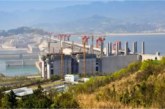The world as a whole in general and developing countries, including India and Pakistan, in particular, are suffering from vast water shortages. The water deficit has emerged and is growing rapidly in recent times and remains largely unnoticed. In terms of remedial, most countries are “managing” water shortage problem, rather than “solving” it. Many countries do not have any options and are thus relying on gradually increased import of grain and water-related products.
Egypt and Sudan are both facing growing grain deficits as a result of water shortages. Mexico is in similar trouble. Once self-sufficient, both Iran and Egypt are now importing more than 40 percent of their grain demand (wheat & rice). Morocco is importing half of its grain needs while Algeria imports 70 percent. A similar situation prevails in Central Asian and many other countries. Israel is importing more than 90 percent of its food requirement. Since a ton of grain requires approximately 1,000 tons of water, importing grain appears to many countries a most expedient way of importing water.
When China starts importing grain (currently 40 million tons of annual shortfall is being met out of their vast reserves), and enters the world grain market, grain prices can be expected to skyrocket despite the heavy subsidies being provided by USA and some other rich countries, partly for food security and partly to keep the world prices stable.
Yields in many countries are still low, which means there is the potential for sufficient food to be available in the short-term future. However, climatic and political changes could push the food prices one way or another.
Water in Pakistan
Water continues to remain in Pakistan a critical resource for sustained economic development. The Irrigation Network of Pakistan is the largest infrastructural enterprise accounting for about $ 300 billion of investment (at current rates) and contributing approximately $ 16 billion, or nearly 25% to the country’s GDP. Irrigated agriculture provides 90 percent of food and fiber requirements while rain-fed area contributes the remaining 10 percent.
Pakistan owns the largest contiguous irrigated area in the world. The Indus Basin System has 3 super dams (besides 68 other large dams according to ICOLD definition), 19 river barrages, 12 inter-river link canals, 45 huge canal commands, and over 600,000 tubewells, besides nearly 18,000 km of drainage network to dispose of agricultural effluent with one drain taking a sizeable part of the saline effluent right into the sea.
About 93% of the water currently utilized in Pakistan goes to irrigation and the rest is used for supplies to urban and rural populations and industry. However, with Pakistan’s population set to increase by 50% by year 2025, the percentage of water required, particularly for urban water supply, is set to increase dramatically. This will place further pressure on water resources which are already deficient in meeting demands across all sectors.
The immediate water shortage crisis in Pakistan is severe, and experts maintain that the long-term forecast is even bleaker. Meteorologists, who blame the prolonged drought on the La Nina weather phenomenon, warn that Pakistan has entered a dry cycle and can expect drought-like conditions to return every six years. Experts predict that with prevailing consumption rates and a population growth of 4 million people a year, one out of three people in Pakistan will face critical shortages of water, threatening their very survival.
Experts in Pakistan feel that the development of major water resources has been mired by political controversy. This constraint, combined with shortage of investment to maintain and improve the system and some institutional shortcomings, is leading to deterioration of the infrastructure as well as inefficient and inequitable use of precious water.
The future is likely to be dominated by increasing pressure on water, both driven by the
increasing population (set to increase by over 50% by year 2025) and rising urbanization (the urban population is expected to double in the next 25 years). This will require significant investment and improvements in the management, efficiency and equity of availability and service delivery. Increased water storage will be required not only to offset that is being lost to sedimentation but also to increase the availability and reliability of water during low flow periods.
The rising competition for water can be seen against increasing concerns about the deterioration of water quality and the environment. Lack of effective waste water treatment facilities and saline drainage effluent are resulting in increasing pollution loads on the river system as well as the salinization of farm lands. Gradually declining water availability and quality raises serious concerns for wetland, riverine and delta ecology.
Observers feel that there is now the need to develop a ‘blue revolution’, which in the short run should provide the necessary quantum increases in availability, service delivery, usage efficiencies and equities in the most important input, namely, water, in order to meet the production, the public health and the environmental needs.
Thus, attainment of sustained self-sufficiency in food, alleviation of poverty and combating environmental degradation etc., call for conservation of water and maximization of production per unit of water.
Viewed in a broad spectrum, the development of water resources is sustainable only if it meets the needs of the present without compromising the ability of the future generations. Pakistan has entered the 21st century with a formidable challenge in water resources development, resource use efficiency and environmental protection, in which the availability of water for household use and food production will continue to remain dominant.
National Water Policy
Recently the government of Pakistan has formulated a Draft National Water Policy. The salient points of this draft water policy are summed here for the information of readers:
In order to undertake basin-wide planning and coordinated development of water resources in the country, there is need to:
1.1 Adopt the principles of Integrated and Unified River Basin Development to ensure that all aspects of water are properly taken care of in decision-making for water resources development.
1.2 Prepare Water Resource Plans for development:
In co-ordination with the policies and projects of other sectors, both public and private;
In accordance with Planning and Regulatory Zones; and
In accordance with Manuals of Good Practice.
1.3 Ensure that water resource plans include sufficient attention to both conservation and enhanced efficiency of water utilization in all sectors.
1.4 Ensure that water-resource plans take a balanced approach to development across all sectoral uses and that water supplies are equitable and sustainable and that existing water rights are protected. Ensure that surface and groundwater resources are developed and utilized sustainably and conjunctively and that water is considered as an economic and social resource.
1.5 Prepare and adopt conservation and demand management strategies, including public awareness programmes, to reduce water requirements (without compromising productivity) across all sectors.
1.6 Ensure that water resource plans are developed that will increase the storage capacity through the development of new reservoirs in and outside the Indus Basin, to realize the vision of ensuring availability of sufficient water for all sectors up to and beyond 2025, particularly during critical months of the year. Ensure that the environmental consequences of this are determined and mitigated. Pakistan’s irrigation network development has now reached a mature stage where the concept of carryover storages, being used world-wide, needs to be seriously considered to overcome drought years.
1.7 Ensure that in water resources planning, water quality is given as much importance as quantity
1.8 Do not consider developing navigation, in the rivers, inter-river links and canal system, since it is neither technically nor economically feasible, except in the lower reaches of the Main Indus.
1.9 Promote delineation of the following Zones by the Provincial agencies to ensure that within each Zone the development of water is planned effectively:
Water Resources Planning Zones in areas where competition for limited water is high;
Flood Risk Planning and Regulatory Zones in flood prone areas.
Fresh and Saline Groundwater Zones.
Groundwater Management Planning and Regulatory Zones in areas where the water table needs to be effectively managed.
Drought Prone Planning Zones to ensure that adequate plans are in place when and where droughts occur.
Watershed Management Zones in upland areas.
Environmental Management Zones in areas of environmental hazard.
1.10 Assess and monitor the impacts of climate change on water resources development and account for these impacts in future water development strategies.
1.11 Undertake Initial Environmental Evaluation Studies (ZEES) and/or Environmental Impact Assessments (EIA) for all water sector development projects, whichever is appropriate.
1.12 Undertake, encourage and support research and development of improved water
management strategies for increasing efficiency, productivity and judicious use of available resources.
Article published in THIRD CONCEPT/August 2008 Issue/Vol-22/No.258


